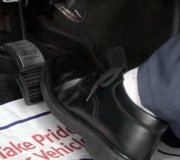Hi,
We are not permitted to reply on the phone. I'm sorry. Listen, are you getting fluid from each wheel when you bleed them? Have you started from the wheel furthest away from MC (RR, LF, RF, LF)? Also, there are two options when it comes to rear brakes, disc or drum. Are you sure the rear brakes are properly adjusted? If everything I mentioned is good, you still have air in the system. You will need to perform an automated bleed procedure which requires a scan tool. I suspect there is air in the abs.
Here are the directions which start the same as traditional bleeding. However, at step 10 is where the computer has to do its job. Since you have some pedal, this is my first suspect.
__________________________________________________
2000 Chevy Truck K 2500 Truck 4WD V8-6.0L VIN U
Automated Bleed Procedure
Vehicle Brakes and Traction Control Hydraulic System Brake Bleeding Service and Repair Procedures Automated Bleed Procedure
AUTOMATED BLEED PROCEDURE
Important:
Use the two-person bleed procedure under the following conditions:
- Installing a new Electro-Hydraulic Control Unit (EHCU) or new Brake Pressure Modulator Valve (BPMV).
- Air is trapped in the valve body
Do not drive the vehicle until the brake pedal feels firm.
Do not reuse brake fluid that is used during bleeding.
Use the vacuum, the pressure and the gravity bleeding procedures only for base brake bleeding.
Two Person Procedure
1. Raise the vehicle in order to access the system bleed screws.
2. Bleed the system at the right rear wheel first.
3. Install a clear hose on the bleed screw.
4. Immerse the opposite end of the hose into a container partially filled with clean DOT 3 brake fluid.
5. Open the bleed screw 1/2 to one full turn.
6. Slowly depress the brake pedal. While the pedal is depressed to its full extent, tighten the bleed screw.
7. Release the brake pedal and wait 10 - 15 seconds for the master cylinder pistons to return to the home position.
8. Repeat the previous steps for the remaining wheels. The brake fluid which is present at each bleed screw, should be clean and free of air.
9. This procedure may use more than a pint of fluid per wheel. Check the master cylinder fluid level every four to six strokes of the brake pedal in order to avoid running the system dry.
10. Press the brake pedal firmly and run the Scan Tool Automated Bleed procedure (all except diesels above 15,000 GVW) once, or run the Function Test (diesels above 15,000 GVW) four times. Release the brake pedal between each test.
11. Bleed all four wheels again using Steps 3 - 9. This will remove the remaining air from the brake system.
12. Evaluate the feel of the brake pedal before attempting to drive the vehicle.
13. Bleed the system as many times as necessary in order to obtain the appropriate feel of the pedal.
_______________________________________
Let me know if that helps.
Joe
Monday, February 22nd, 2021 AT 5:26 PM
(Merged)




